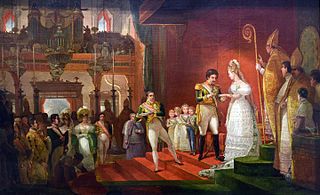
A stepmother, stepmum or stepmom is a female non-biological parent married to one's preexisting parent. Children from her spouse's previous unions are known as her stepchildren. A stepmother-in-law is a stepmother of one's spouse.
The Birth of Merlin, or, The Child Hath Found his Father is a Jacobean play, probably written in whole or part by William Rowley. It was first performed in 1622 at the Curtain Theatre in Shoreditch. It contains a comic depiction of the birth of the fully grown Merlin to a country girl, and also features figures from Arthurian legend, including Uther Pendragon, Vortigern, and Aurelius Ambrosius.
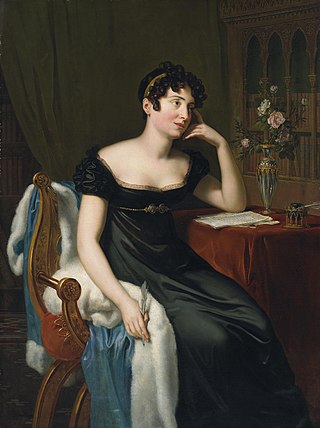
Sydney, Lady Morgan, was an Irish novelist, best known for The Wild Irish Girl (1806), a romantic, and some critics suggest, "proto-feminist", novel with political and patriotic overtones. Her work, including continental travelogues, sparked controversy and faced censorship. She counted Percy Bysshe Shelley and Lord Byron among her defenders.
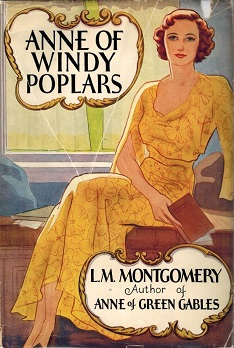
Anne of Windy Poplars—published as Anne of Windy Willows in the UK, Australia, and Japan—is an epistolary novel by Canadian author L. M. Montgomery. First published in 1936 by McClelland and Stewart, it details Anne Shirley's experiences while serving as principal of a high school in Summerside, Prince Edward Island over three years. A large portion of the novel is presented through letters Anne writes to her fiancé, Gilbert Blythe. Chronologically, the book is fourth in the series, but it was the seventh book written.
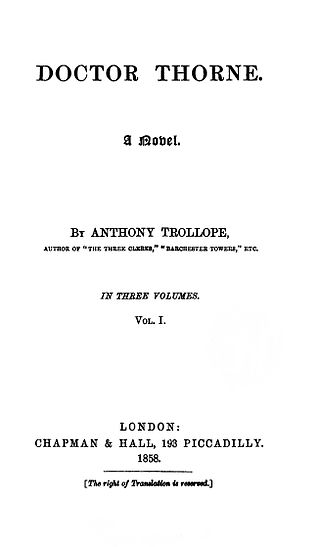
Doctor Thorne is the third novel written by Anthony Trollope in his Chronicles of Barsetshire series, between Barchester Towers and Framley Parsonage. It was published by Chapman and Hall in London in 1858. The idea of the plot was suggested to Trollope by his brother Thomas. Though set in Barsetshire, Barchester and its residents take little part in the proceedings. The novel is mainly concerned with money and position.

A Damsel in Distress is a novel by P. G. Wodehouse, first published in the United States on 4 October 1919 by George H. Doran, New York, and in the United Kingdom by Herbert Jenkins, London, on 15 October 1919. It had previously been serialised in The Saturday Evening Post, between May and June of that year.

Pamela; or, Virtue Rewarded is an epistolary novel first published in 1740 by the English writer Samuel Richardson. Considered one of the first true English novels, it serves as Richardson's version of conduct literature about marriage.

"East of the Sun and West of the Moon" is a Norwegian fairy-tale. It was included by Andrew Lang in The Blue Fairy Book (1889).
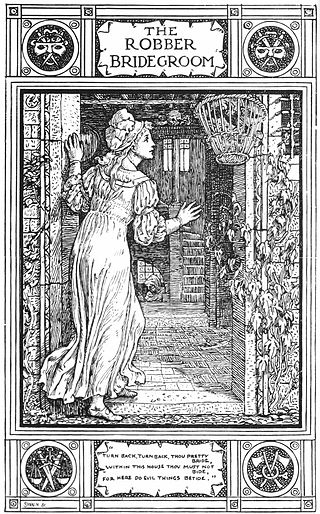
"The Robber Bridegroom" is a German fairy tale collected by the Brothers Grimm, tale number 40. Joseph Jacobs included a variant, Mr Fox, in English Fairy Tales, but the original provenance is much older; Shakespeare alludes to the Mr. Fox variant in Much Ado About Nothing, Act 1, Scene 1:

The Enchanted Pig is a Romanian fairy tale, collected in Rumanische Märchen and also by Petre Ispirescu in Legende sau basmele românilor. Andrew Lang included it in The Red Fairy Book.
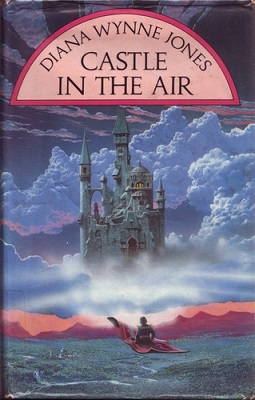
Castle in the Air is a young adult fantasy novel written by Diana Wynne Jones and first published in 1990. The novel is a sequel to Howl's Moving Castle and is set in the same fantasy world, though it follows the adventures of Abdullah rather than Sophie Hatter. The plot is based on stories from the Arabian Nights. The book features many of the characters from Howl's Moving Castle as supporting characters, often under some sort of disguise.
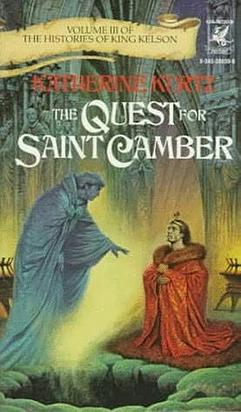
The Quest for Saint Camber is a historical fantasy novel by American-born author Katherine Kurtz. It was first published by Del Rey Books in 1986. It was the ninth of Kurtz' Deryni novels to be published, and the third book in her third Deryni trilogy, The Histories of King Kelson. Just as the Histories trilogy is a direct sequel to the first Deryni trilogy, The Chronicles of the Deryni, the next Deryni trilogy to be published, The Heirs of Saint Camber, is a direct sequel to Kurtz' second Deryni trilogy, The Legends of Saint Camber. In 2000, Kurtz published her thirteenth Deryni novel, King Kelson's Bride, which is a direct sequel to the events of The Quest for Saint Camber.
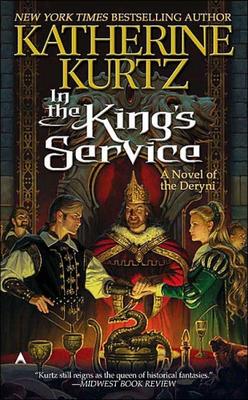
In the King's Service is a historical fantasy novel by American-born author Katherine Kurtz. It was first published by Ace Books in 2003. It was the fourteenth of Kurtz' Deryni novels to be published, and the first book in the fifth Deryni trilogy, the Childe Morgan trilogy. The events of this trilogy are a direct prequel to the first Deryni trilogy, the Chronicles of the Deryni.
Events from the year 1806 in Ireland.

Sir Thomas Charles Morgan was an English physician and writer with an interest in philosophical and miscellaneous subject matter. His wife was the novelist Lady Morgan.
"The Necklace of Princess Fiorimonde" is a fairy tale written by Mary De Morgan (1850–1907) in her collection of short stories called "The Necklace of Princess Fiorimonde and Other Stories." This collection of fairy tales originally published in 1880. Mary de Morgan helped to make the Victorian era prominent in literature. In her short stories, she is able to use "mystery, pathos, and comedy" to create entertaining and imaginative literature for all to enjoy. In addition, de Morgan uses both female and male protagonists in her writing exhibiting her belief in equality among the sexes. In many of her works, Mary de Morgan uses elements from the folk tales of medieval England. This is apparent in the universality of her literature, as it was easily relatable to all in Victorian England despite the different socioeconomic classes.
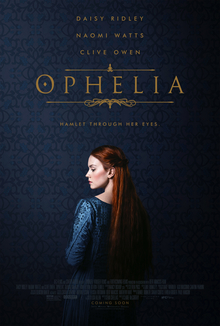
Ophelia is a 2018 historical romantic drama film directed by Claire McCarthy and written by Semi Chellas about the character of the same name from William Shakespeare's play Hamlet. Based on the novel by Lisa Klein, the film follows the story of Hamlet from Ophelia's perspective. It stars Daisy Ridley in the title role, alongside Naomi Watts, Clive Owen, George MacKay, Tom Felton and Devon Terrell. The dialogue is in modern English.
Clarke, Lady Olivia, was a poet and Irish dramatist, best known as the author of The Irishwoman, a comedy in five acts
The Story of Princess Zeineb and King Leopard is a French language fairy tale published in the 18th century. The tale belongs to the international cycle of the Animal as Bridegroom as a subtype, with few variants reported across Europe. In it, the heroine is delivered to a cursed or enchanted prince, but breaks a taboo and loses him; later, she finds work elsewhere and wards off the unwanted advances of male suitors with the magical object her enchanted husband gave her.
María, manos blancas is a Spanish fairy tale from Extremadura, collected by Spanish author Marciano Curiel Merchán. The tale belongs to the international cycle of the Animal as Bridegroom as a subtype, with few variants reported across Europe and in Spain. In it, the heroine is delivered to a cursed or enchanted prince, but breaks a taboo and loses him; later, she finds work elsewhere and wards off the unwanted advances of male suitors with the magical object her enchanted husband gave her.














